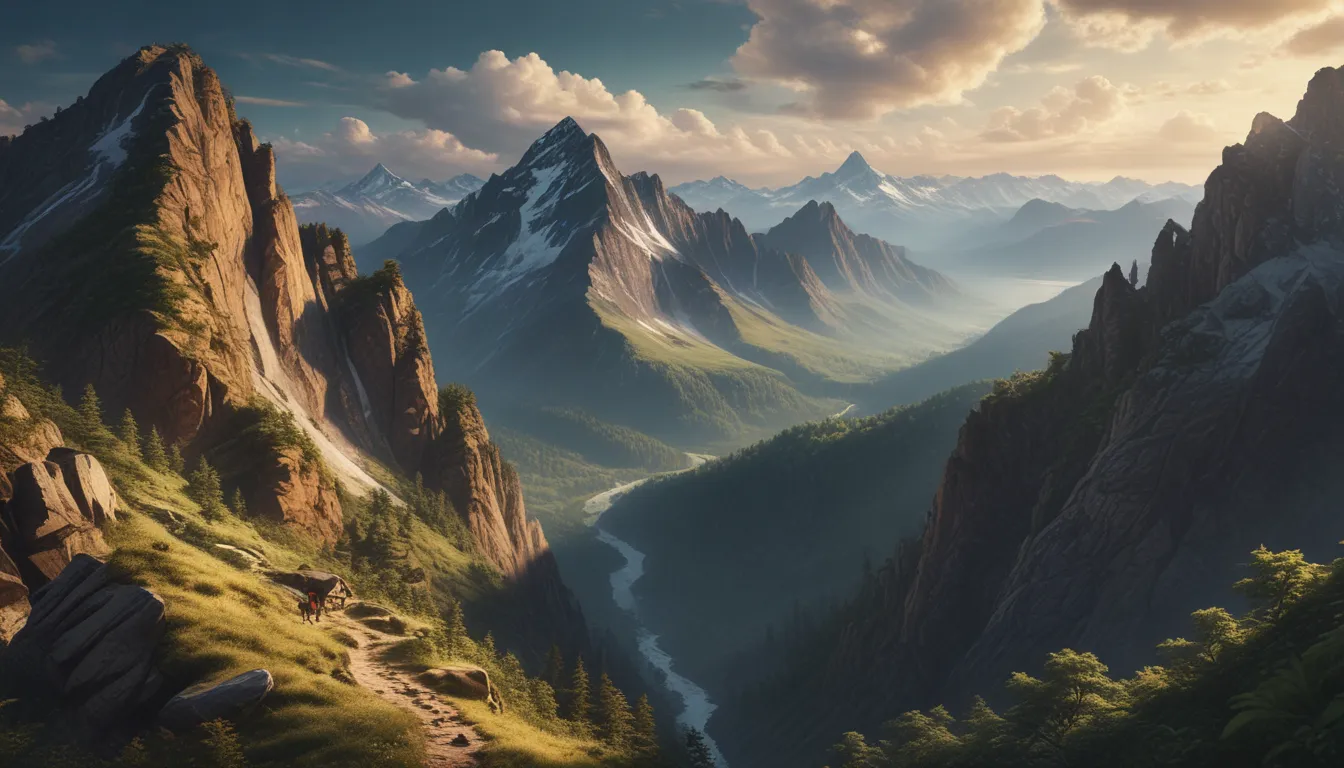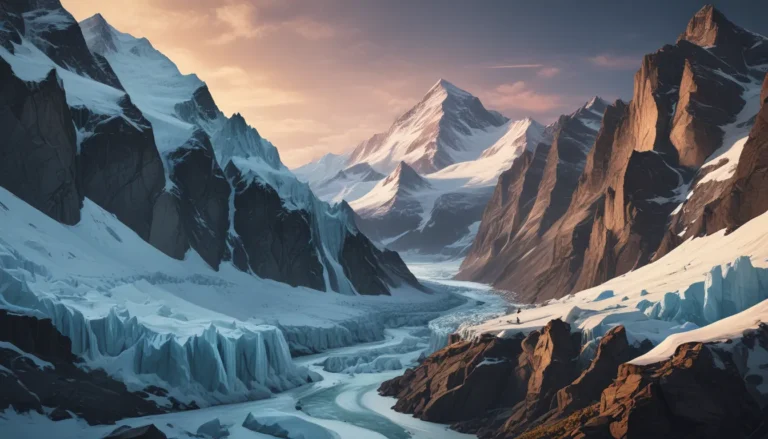A Note About Images: The images used in our articles are for illustration purposes only and may not exactly match the content. They are meant to engage readers, but the text should be relied upon for accurate information.
Mountains stand tall and proud, commanding our attention and inspiring us with their majestic beauty. From the highest peaks to the oldest ranges, mountains are more than just landforms; they hold a wealth of surprises waiting to be uncovered. Join us as we delve into the extraordinary world of mountains and unveil 14 surprising facts that will leave you in awe. Discover the diverse ecosystems, ancient formations, and cultural significance that make mountains such breathtaking wonders.
Unveiling the Majesty of Mountains
Mountains are not just geographic features; they are living entities that shape our world in remarkable ways. Each mountain possesses its own unique story, beauty, and significance, making them fascinating to explore and admire. Let’s dive into the world of mountains and uncover the hidden wonders that lie within.
The Tallest Peak: Mount Everest
Towering at a stunning height of 29,029 feet (8,848 meters), Mount Everest reigns as the tallest mountain on Earth, challenging adventurers and captivating explorers with its awe-inspiring presence. The sheer magnitude of Everest’s height is a testament to the power and grandeur of nature.
The Andes: A Continental Giant
Stretching over 4,300 miles (7,000 kilometers) across seven South American countries, the Andes Mountains form the longest continental mountain range in the world. From Argentina to Chile, Peru to Ecuador, the Andes dominate the landscape with their majestic peaks and diverse ecosystems.
Ecological Diversity: Mount Kilimanjaro
In Tanzania, Mount Kilimanjaro boasts five distinct ecological zones, ranging from lush rainforests to arctic-like glaciers. Climbers journey through a unique blend of ecosystems as they ascend Kilimanjaro, experiencing a diverse range of landscapes unlike anywhere else on Earth.
The Roof of Europe: The Alps
The Alps, spanning eight European countries, hold the title of the “Roof of Europe” due to their extraordinary height and breathtaking views. From Switzerland to Italy, Austria to France, the Alps offer panoramic vistas that showcase the beauty of the continent.
A Formidable Challenge: K2
Located on the border between China and Pakistan, K2 (Mount Godwin-Austen) stands as the second-highest mountain in the world, reaching an impressive height of 28,251 feet (8,611 meters). Climbers face a daunting challenge as they attempt to conquer the mighty peak of K2.
Ancient Guardians: The Appalachian Mountains
Formed over 480 million years ago, the Appalachian Mountains are the oldest mountain range in North America, spanning over 1,500 miles (2,400 kilometers). Hikers and nature enthusiasts are drawn to the Appalachian’s ancient rock formations and rich biodiversity, immersing themselves in its timeless beauty.
A Natural Divide: The Ural Mountains
Stretching across 1,550 miles (2,500 kilometers), the Ural Mountains serve as a natural boundary between Europe and Asia, shaping the geographical and cultural landscape of the continents. The Ural Mountains stand as a testament to the powerful forces that shape our world.
The Highest Summits: The Himalayas
With over 100 mountains exceeding 23,622 feet (7,200 meters), the Himalayas boast the highest peaks on Earth, including the legendary Mount Everest. The Himalayas are not just a mountain range; they are a symbol of resilience and strength that inspire awe and wonder.
Exploring the Beauty of Mountains
Mountains are more than just geological formations; they are living entities that play a crucial role in shaping our planet’s landscape and climate. Whether you’re admiring the iconic Matterhorn or trekking through the Rocky Mountains, each mountain offers a unique experience that will leave you breathless. Step into the world of mountains and discover the wonders that await you.
Iconic Beauty: The Matterhorn
Standing tall at 14,692 feet (4,478 meters) on the Swiss-Italian border, the Matterhorn is one of the most iconic mountains in the world, renowned for its distinctive pyramid-like shape. Climbers and photographers alike are drawn to the Matterhorn’s majestic presence, making it a must-see destination for adventurers.
Wilderness Majesty: The Rocky Mountains
Stretching over 3,000 miles (4,800 kilometers) from the United States to Canada, the Rocky Mountains showcase breathtaking scenery, diverse wildlife, and iconic national parks like Yellowstone and Rocky Mountain. Hikers and nature lovers flock to the Rockies to immerse themselves in the beauty of these wild landscapes.
Cultural Heritage: Drakensberg Mountains
South Africa’s Drakensberg Mountains are not only visually stunning but also hold historical and cultural significance. Featuring magnificent sandstone cliffs, ancient rock art sites, and awe-inspiring peaks, the Drakensberg Mountains are a UNESCO World Heritage Site that captures the imagination of all who visit.
Mineral Wealth: Tien Shan Mountains
Spanning across Central Asia, the Tien Shan Mountains are rich in mineral resources, including gold, silver, and rare earth elements. Mining expeditions are drawn to the Tien Shan Mountains for their vast reserves, contributing to the region’s economy and development.
Sublime Peaks: Sierra Nevada Mountains
In California, the Sierra Nevada Mountains are home to Mount Whitney, the highest peak in the contiguous United States at 14,505 feet (4,421 meters). Adventurers brave challenging trails and breathtaking views as they conquer the towering summit of Mount Whitney.
Deepening Your Appreciation for Mountains
As you journey through the intricate world of mountains, you’ll gain a newfound appreciation for these majestic wonders that shape our planet’s landscape and history. Mountains are not just geographical features; they are guardians of biodiversity, cultural heritage, and natural resources. Whether you’re scaling the heights of Mount Everest or admiring the beauty of the Appalachian Mountains, let these surprising facts about mountains enrich your understanding and appreciation of these awe-inspiring giants.
FAQs
How are mountains formed?
Mountains are formed through tectonic plate movements and volcanic activities. When two plates collide, they create mountain ranges through processes like compression, folding, and faulting.
What is the highest mountain in the world?
Mount Everest, located in the Himalayas, stands as the world’s tallest peak at 29,032 feet (8,848 meters) above sea level.
Do mountains influence weather patterns?
Yes, mountains have a significant impact on weather patterns by blocking or redirecting air masses, leading to variations in temperature, humidity, and precipitation on either side of the mountain range.
Are there animals living in mountains?
Mountains are home to a wide variety of animals, including snow leopards, mountain goats, and diverse bird species. These high-altitude habitats support unique flora and fauna adapted to survive in mountain environments.
How do mountains contribute to the water cycle?
Mountains play a crucial role in the water cycle by capturing and storing precipitation as snow and ice, which gradually melt and flow downstream to provide fresh water to rivers and lakes in lower elevations.
Can mountains cause earthquakes?
Yes, mountains can be associated with seismic activity due to tectonic plate movements and the formation of mountain ranges, leading to earthquakes in regions experiencing high tectonic stress.
Mountains are not just geological features; they are living entities that shape our world in profound ways. As you explore the extraordinary world of mountains, let these surprising facts ignite your curiosity and deepen your appreciation for these majestic wonders. From the towering peaks of the Himalayas to the ancient formations of the Appalachians, mountains stand as testaments to nature’s power and beauty. So, embrace the adventure, immerse yourself in the beauty of mountains, and let their secrets enchant you on your journey of discovery.






